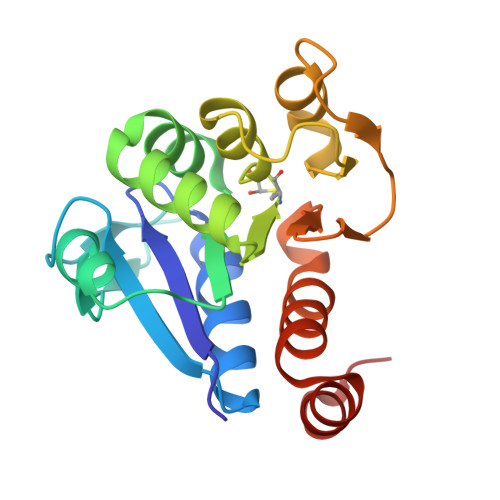Stereospecific mechanism of DJ-1 glyoxalases inferred from their hemithioacetal-containing crystal structures.
Choi, D., Kim, J., Ha, S., Kwon, K., Kim, E.H., Lee, H.Y., Ryu, K.S., Park, C.(2014) FEBS J 281: 5447-5462
- PubMed: 25283443
- DOI: https://doi.org/10.1111/febs.13085
- Primary Citation of Related Structures:
4OFW, 4OGF, 4OGG - PubMed Abstract:
DJ-1 family proteins have recently been characterized as novel glyoxalases, although their cofactor-free catalytic mechanisms are not fully understood. Here, we obtained crystals of Arabidopsis thaliana DJ-1d (atDJ-1d) and Homo sapiens DJ-1 (hDJ-1) covalently bound to glyoxylate, an analog of methylglyoxal, forming a hemithioacetal that presumably mimics an intermediate structure in catalysis of methylglyoxal to lactate. The deuteration level of lactate supported the proton transfer mechanism in the enzyme reaction. Differences in the enantiomeric specificity of d/l-lactacte formation observed for the DJ-1 superfamily proteins are explained by the presence of a His residue in the active site with essential Cys and Glu residues. The model for the stereospecificity was further evaluated by a molecular modeling simulation with methylglyoxal hemithioacetal superimposed on the glyoxylate hemithioacetal. The mechanism of DJ-1 glyoxalase provides a basis for understanding the His residue-based stereospecificity. Structural data have been submitted to the Protein Data Bank under accession numbers 4OFW (structure of atDJ-1d), 4OGF (structure of hDJ-1 with glyoxylate) and 4OGG (structure of atDJ-1d with glyoxylate).
Organizational Affiliation:
Division of Magnetic Resonance Research, Korea Basic Science Institute, Chungcheongbuk-Do, South Korea; Department of Biological Science, Korea Advanced Institute of Science and Technology, Daejeon, South Korea.



















